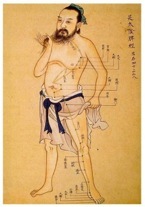Acupuncture
The practice of acupuncture is based on the principles of Traditional Chinese Medicine, developed systematically over a period of at least 3000 years. Its effectiveness, safety, and lack of side effects make it a highly effective treatment for many conditions. In Traditional Chinese Medicine, the body’s life energy or Qi (pronounced “chee”) flows through the body in channels called meridians. Acupuncture meridians, which have been mapped over thousands of years, 'connect the inner organs within and the limbs without,' enabling a person's 'Qi' and blood to flow smoothly throughout the whole body. Channels connecting the inner, outer, upper, and lower body allow our everyday living processes to function as a unified whole.
Health problems arise when there is an obstruction in the flow of Qi or when the supply of Qi is inadequate. Acupuncture involves inserting very fine, pre-sterilized, disposable (one time use) surgical grade stainless steel needles into specific points to adjust and stimulate the flow of Qi, thereby restoring health and normal function. When appropriate, acupuncture may be combined with other oriental medicinal methods, such as moxibustion, acupressure or cupping. Modern research has shown that stimulating acupuncture points in the meridians decreases inflammation, increases endorphins to relieve pain, regulates blood circulation, hormone secretion, and boosts the immune system. Acupuncture can treat cases in internal medicine, gynaecology, dermatology, ophthalmology, and ENT.
The World Health Organization (WHO) has identified a large number of diseases, symptoms or conditions for which acupuncture has been proved-through controlled trials-to be an effective treatment. The list can be seen at the WHO website here: http://apps.who.int/medicinedocs/en/d/Js4926e/5.html#Js4926e.5

ABOUT
TRADITIONAL
CHINESE
MEDICINE
Traditional Chinese Medicine (TCM) encompasses several treatment modalities identified individually in English as acupuncture, fire cupping, Gua Sha, moxibustion, and herbal medicine. Traditional Chinese Medicine has a documented history of more than 3000 years, and is still the primary form of medical treatment for the more than 1.3 billion people in China today.
Fire cupping is a method of applying acupressure by creating a vacuum next to the patient's skin. In traditional Chinese Medicine it involves placing glass cups on the skin with a vacuum created by heating the air inside the cup. Cupping therapy is used to treat back, neck, shoulder, and other musculoskeletal pain, and may also be used to treat respiratory diseases such as bronchitis. Fire Cupping may used in conjunction with Tuina therapy for maximum relief of symptoms.
Gua Sha is a healing technique widely used by practitioners of Traditional Chinese Medicine, but little known in the West. It involves palpation and cutaneous stimulation where the skin is pressured, in strokes, by a round-edged instrument; this results in the appearance of small red petechiae called 'sha', that will fade in 2 to 3 days. Gua Sha removes blood stagnation considered pathogenic, promoting normal circulation and metabolic processes.The patient experiences immediate relief from pain, stiffness, fever, chill, cough, nausea, and so on. Gua Sha is valuable in the prevention and treatment of acute infectious illness, upper respiratory and digestive problems, and many other acute or chronic disorders.
Moxibustion is the burning of an herb called Mugwort. In Traditional Chinese Medicine, Mugwort is considered to be warm, acrid, and bitter when used in herbal prescriptions. When burnt, it has similar properties and, thus, its warming nature is useful for helping to expel cold and damp from the body as well as warming the body’s channels. The bitter and acrid aspects of Mugwort help to break stagnation, clear phlegm, and rectify the qi and blood. One end of a burning moxa stick (made of mugwort herb, roughly the shape and size of a cigar) is held an inch or two away from the skin, usually around the inserted acupuncture needles to bring mild warmth to the area until the skin becomes slightly red. The intensity of the heat is adjusted according to the patient’s condition and comfort. Indirect moxa is considered to induce a gradual localized vasodilatation response. In addition to increasing the local blood flow, skillful indirect moxibustion is extremely comforting and can create a deep relaxation response.
Chinese Herbal Medicine is part of the ancient healing art of Traditional Chinese Medicine (TCM). TCM has been evolving during the last 5,000 years. Chinese herbs are used to restore the "Qi" or energy of the body by bringing into balance the opposing forces of Yin and Yang. TCM believes that the imbalance of Yin and Yang creates blockage in Qi which results in illness. Through 5,000 years of research and natural selection, TCM has been able to identify combinations of herbs that are particularly effective in restoring the balance between Yin and Yang under many different conditions. The result, according to TCM, is a return of the flow of Qi throughout the body and an improvement in general physical and mental health.





Tel: 902-407-4355 email:qing.therapy@gmail.com 604 Bedford Highway,Suite 201 Halifax, NS B3M 2L8
Quick Links:
css menus by Css3Menu.com

Qing Li Chinese Therapy
ACUPUNCTURE
Traditional Chinese Medicine
css menus by Css3Menu.com
*Qing Li Chinese Therapy, all results may vary on a individual basis so we make no guarantees, warranties or representations, implied or express, as to the appropriateness, timeliness, accuracy, completeness, and/or usefulness of any of the information, opinions, advice, services, data or other information contained or referenced on this website. Qing Li Chinese Therapy assumes no risk or obligation for your use of this website. Persons who visit and use this site are hereby advised and need to be fully aware that there are many controversies in the research, diagnosis and treatment. Further, information and understanding about any of our treatments are in a constant state of change. As the Qingli.ca website is only updated on a periodic basis, the site may not contain the most recent and updated medical information. Qing Li Chinese Therapy reserves the right to update or change information contained on this website at any time.*